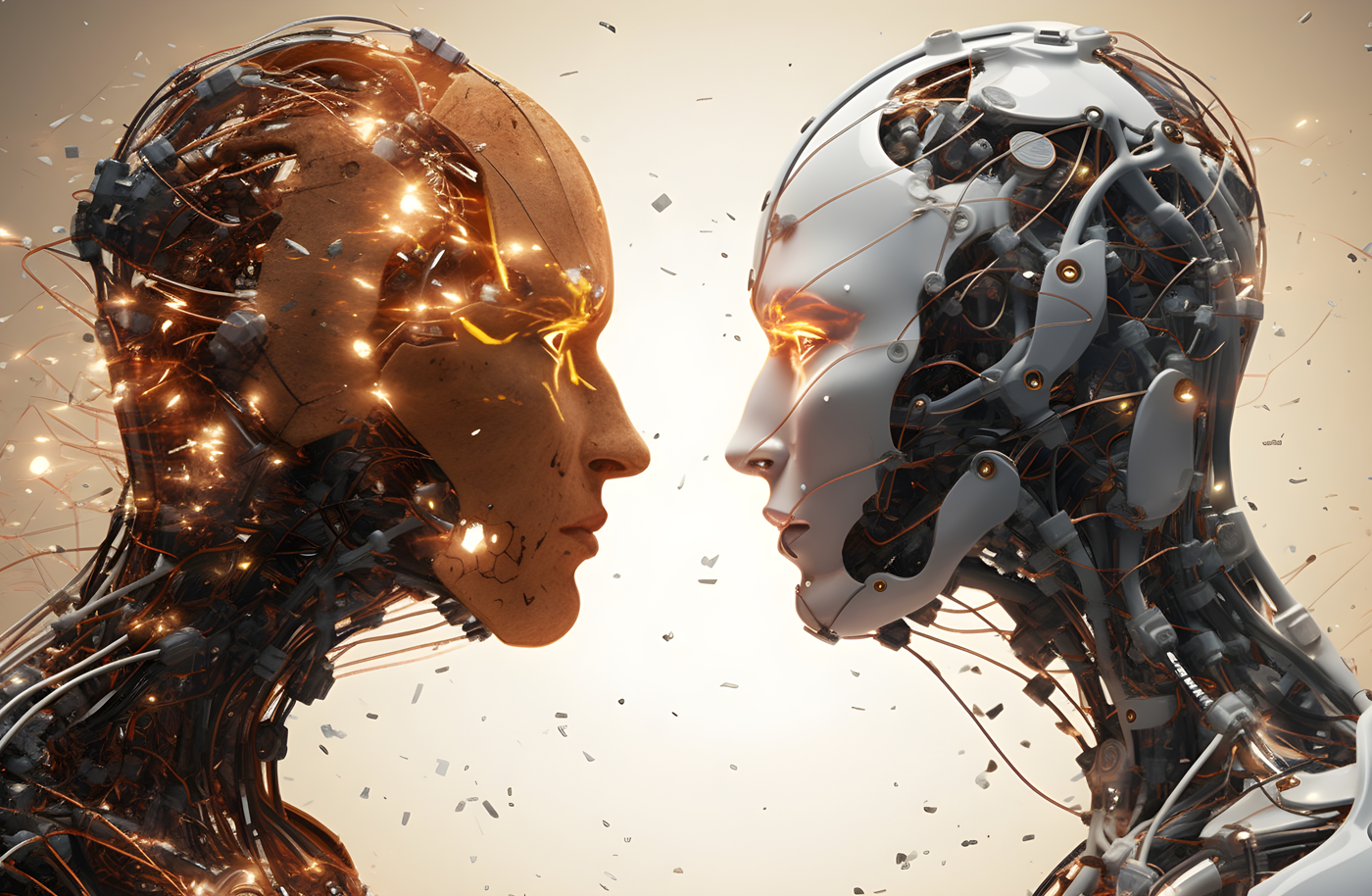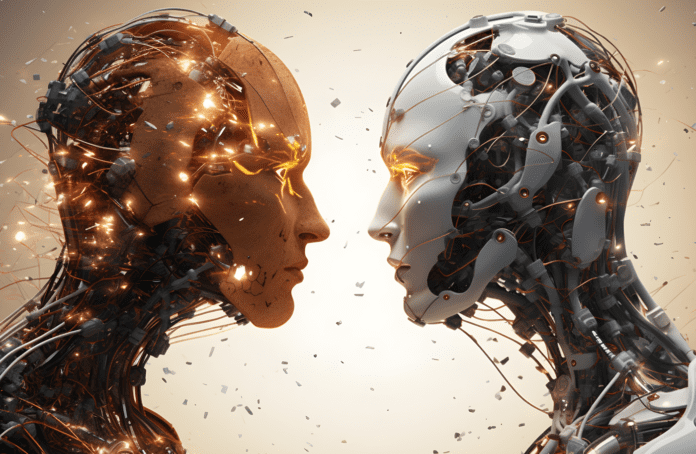
Generative artificial intelligence (AI) is valued for its ability to create new content, including text, images, video, and music. It uses AI algorithms to analyze patterns in datasets to mimic style or structure to replicate different types of content, and can be used to create deep-fake videos and voice messages.
Generative AI is a subset of artificial intelligence, which also includes a broad range of technologies that enable machines to perform tasks that once required human intelligence and judgment. It’s often used to build systems with the cognitive capacity to mine data, and it continuously boosts its performance over the course of repeated events. Here’s what you need to know about the benefits and logistics of using AI and generative AI as well as the ethical concerns of which to be aware.
KEY TAKEAWAYS
- •Generative AI focuses on creating new content, while traditional AI focuses on analyzing and interpreting data.
- •Generative AI requires significant computational resources and large datasets, whereas traditional AI can be more compute efficient.
- •Ethical considerations for both include bias, security, and privacy concerns.
- •Generative AI use cases tend to be in music, design, and marketing, while traditional AI use cases are found in finance, healthcare, and manufacturing.
Key Differences Between Generative AI and Traditional AI
Both generative AI and artificial intelligence, sometimes called “traditional AI,” use machine learning algorithms to obtain their results. However, they have different goals and purposes. Generative AI is intended to create new content, while AI goes much broader and deeper—in essence, to wherever the algorithm coder wants to take it. AI’s possible deployments include better decision-making, removing the tedium from repetitive tasks, or spotting anomalies and issuing alerts for cybersecurity. The following summary spells out the common differences between generative AI and AI:
- Focus and Output: Traditional AI focuses on analyzing and interpreting existing data to improve efficiency, accuracy, and decision-making as it operates within predefined boundaries. Generative AI, however, is designed to create text, images, music, and models based on existing data.
- Implementation: Traditional AI is primarily used in applications such as predictive analytics, natural language processing (NLP), and autonomous systems. In contrast, generative AI is utilized in creative fields like content creation, design, and entertainment, as well as scientific research where new hypotheses and models are needed.
- Transparency: Traditional AI models are generally more transparent and interpretable. Generative AI models, especially those using deep learning techniques, often function as “black boxes,” making their decision-making processes less transparent.
- Performance and Efficiency: Generative AI models, particularly large language models like GPT-4, require substantial computational resources and training time, making it more difficult to scale compared to traditional AI, which can be more efficient, especially when dealing with specific, well-defined tasks that do not require extensive model training.
- Data Requirements and Training: Generative AI typically requires large datasets for training to ensure the generated content is diverse and high-quality. Traditional AI can often operate effectively with smaller datasets, depending on the complexity of the task and the model used.
- Adaptability and Flexibility: Generative AI can adapt to various domains and generate content across different fields. Traditional AI, while adaptable to some degree, often needs very specific training for each unique task or application.
Generative AI: An In-Depth View
To fully understand the relationship between generative AI and AI, it’s necessary to understand each of these technologies at a deeper level.
Characteristics of Generative AI
Generative AI is an open-ended and rapidly evolving form of artificial intelligence. Its major characteristics include the following:
- Data-Driven Learning: Generative AI relies on unsupervised or self-supervised learning, identifying patterns and relationships without explicit labels.
- Generative Models: Generative AI uses advanced models like GANs, VAEs, and large language models such as GPT-3 and GPT-4, designed to create new data similar to training inputs.
- Creativity and Innovation: A key trait of generative AI is that it can generate original content such as text, images, music, and designs from existing data.
- Adaptability: Generative AI adjusts to new data and environments, which constantly improves its performance. Consequently, it performs an ever wider range of tasks without developers needed to explicitly update its rules.
- Unsupervised and Semi-Supervised Learning: Uses unsupervised and semi-supervised approaches to learn from large amounts of unlabeled data to reduce dependency on labeled datasets.
Advantages of Generative AI
- Adaptability: These models can adapt to new data and continuously improve their outputs without needing explicit rule updates.
- Generalization: These models are good at generalizing across a wide range of tasks in a given domain as they leverage their learned knowledge to solve challenges.
- Data Augmentation: Generative AI easily creates synthetic data to augment existing datasets, which is useful in data-scarce environments.
- Personalization: Because it is so adept at generating content, generative AI gives users personalized experiences by crafting content adapted to individual preferences.
Limitations of Generative AI
- Lack of Transparency: Opacity is an issue because the inner workings of deep learning models can be difficult to interpret, leading to concerns about transparency and accountability in decision-making.
- Ethical Concerns: Generative AI can be misused to generate deep-fake content and other potentially harmful outputs, fanning ethical challenges of misuse and misinformation.
- Quality Control: Making sure that the generated content meets quality standards can be challenging, especially since generative AI is notorious for generating false information.
- Bias: Generative AI models can inadvertently learn and propagate biases present in training data to produce unfair outcomes.
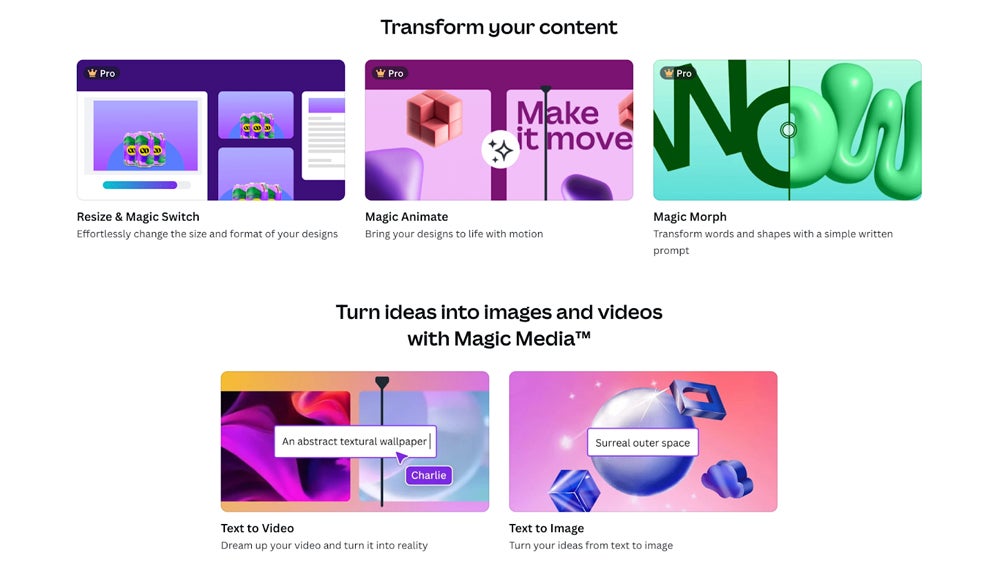 Some of the generative options in Canva’s Magic Studio.
Some of the generative options in Canva’s Magic Studio.
Generative AI Use Cases
With its ability to use source data for any number of creative tasks, generative AI’s use cases range from product design to software development to fraud detection.
Product Design and Personalization
Generative AI helps in creating innovative designs that meet specific performance criteria, from prototyping to optimization of design, while minimizing not only material use but also waste. Additionally, generative AI succeeds at creating highly personalized product experiences by analyzing user data to create products that align with the preferences and needs of individual users. This personalization can help with cheating marketing and sales campaigns.
Creative Content Generation
For the creative industries, generative AI can mimic various artistic styles, compose original music and even generate complete pieces of artwork. This application is expanding the horizons of creative expression and is being used by artists, musicians, and other content creators to increase their output.
Software Development
Generative AI provides the ability to automate code generation, bug fixes, and optimization. This results in more efficient development cycles and higher-quality software. AI tools can also generate synthetic data for training and testing purposes, which plays an important role in developing robust AI applications.
Customer Support and Engagement
Generative AI-powered chatbots and virtual assistants provide 24/7 assistance, personalize interactions, and handle complex queries. These tools raise customer satisfaction and operational efficiency by automating routine support tasks and offering faster responses than human operators.
Fraud Detection and Risk Management
In finance and insurance, generative AI is used to detect fraud and manage risk. It analyzes transaction patterns and identifies anomalies, then helps in creating detailed reports and summaries that aid in decision-making, thereby enhancing the overall security and reliability of financial operations.
The Future of Generative AI
Based on the significant advancements that keep enhancing generative AI’s capabilities, its future is incredibly promising. Expect to see models becoming larger and more powerful, like GPT-4 and PaLM2, which are revolutionizing content creation and personalized customer communications. Such models enable businesses to generate high-quality, human-like outputs more efficiently, with impact seen across many market sectors.
We can also expect to see generative AI models run on a wider variety of hardware devices, which will open up an array of use cases. A notable trend is the rise of multimodal AI models that can understand and generate content across several forms of data, such as text, images, and audio. The result? Users will get more immersive and natural user experiences, especially in fields like virtual reality and augmented reality.
Additionally, generative AI is driving new levels of personalization by improving how it adapts products and services to individual preferences. It’s therefore seen as a particularly aggressive driver of change across retail, marketing and ecommerce sectors.
 An example of generative AI: a beach at sunrise created by DALL-E.
An example of generative AI: a beach at sunrise created by DALL-E.
Traditional AI: An In-Depth View
Although artificial intelligence has enjoyed an enormously higher profile over the last few years, the history of AI stretches back to the 1940s. This traditional AI is the basis for generative AI, and while there are major differences, there is major overlap between these two technologies. To fully understand the topic, here’s a deeper look at artificial intelligence itself.
Characteristics of Traditional AI
Overall, traditional AI is focused on explicit programming to execute tasks with precision. The following are its core characteristics:
- Rule-Based Systems: Traditional AI relies heavily on programming and rule-based algorithms. These systems follow predefined rules and instructions to perform highly defined tasks, meaning they are predictable and reliable within their scope of operation.
- Deterministic Nature: Traditional AI systems are deterministic, meaning they produce the same output for a given input every time. This predictability is essential for applications such as fraud detection and medical diagnostics that need consistent and accurate results.
- Supervised Learning: Traditional AI often utilizes supervised learning techniques, where models are trained on labeled datasets. AI-based applications learn to make predictions or decisions based on the relationships between input-output pairs.
- Pattern Recognition: A core strength of traditional AI is its ability to recognize patterns in structured data, which is useful in many situations, including image recognition, speech recognition, and recommendation systems.
- Scalability in Well-Defined Environments: Traditional AI systems are highly scalable in environments where tasks and data are well-defined and stable. They can efficiently handle large volumes of data and complex decision-making processes without significant increases in computational costs.
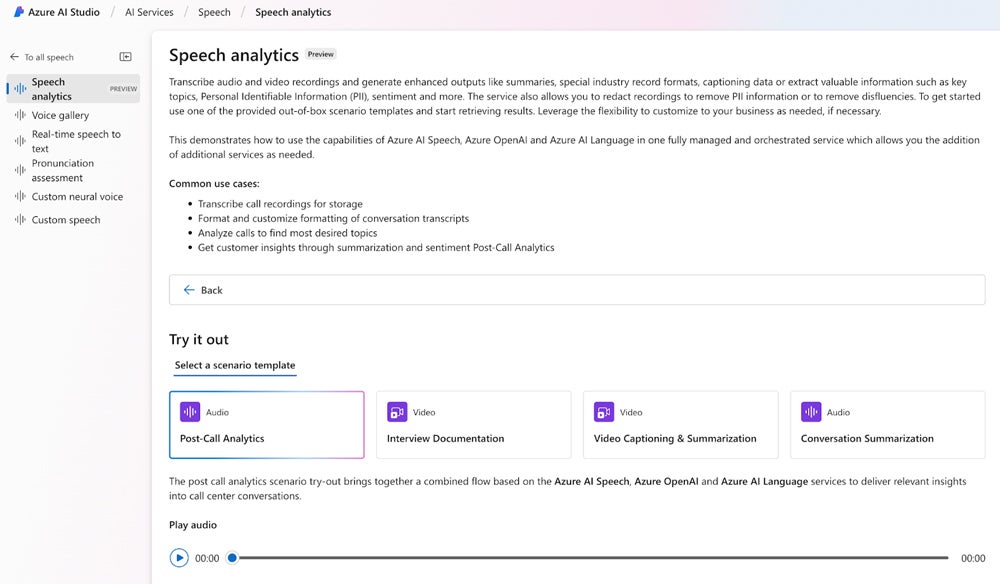 Some of the analytic services available in Azure AI.
Some of the analytic services available in Azure AI.
Advantages of Traditional AI
- High Accuracy: When given tasks with clear objectives and structured data, such as image recognition and data analysis, traditional AI achieves exceptional levels of accuracy.
- Scalability: Traditional AI systems can handle greater volumes of data or more complex decision-making processes without a proportional increase in cost or resources.
- Transparency: Rule-based AI systems are generally more transparent and interpretable compared to generative models.
- Efficiency: Traditional AI models are often less resource-intensive than generative Ai, making them more accessible for a variety of applications.
Limitations of Traditional AI
- Limited Flexibility: Traditional AI models struggle to adapt to new, unseen scenarios, which can hinder their application in dynamic environments.
- Lack of Creativity: Traditional AI is confined to the rules it has been programmed with, meaning it cannot generate new content or solutions beyond its predefined scope.
- Transparency and Explainability: While often more transparent than generative models, some traditional AI models, particularly deep learning ones, can still be opaque.
- Ethical Concerns: AI is not immune to issues related to bias and decision-making processes arising from the data and rules a given system is using.
Traditional AI Use Cases
Artificial intelligence can compute exponentially faster than the fastest team of human experts, even as it handles far greater complexity. This capability enables an array of use cases, ranging from business automation to research and development to cybersecurity.
Business Automation and Optimization
AI-driven automation is streamlining repetitive and manual business operations. Robotic process automation (RPA) uses AI to automate routine administrative tasks, freeing up human workers for more complex activities. AI algorithms are used to optimize supply chain management by predicting demand, managing inventory, and optimizing logistics.
Research and Development
In research and development (R&D), traditional AI accelerates innovation by analyzing huge datasets to identify patterns, predict outcomes, and generate new insights. In pharmaceuticals, AI helps drug discovery by predicting the efficacy of compounds and optimizing clinical trials. In engineering, AI models can be used to optimize product designs, which helps to lower the time and cost associated with bringing new products to market.
Predictive Maintenance
AI is increasingly used for predictive maintenance, with use cases like analyzing data from machinery to predict failures before they occur. This proactive approach helps schedule maintenance activities at optimal times. The benefits include lower downtime and extended equipment lifespans. Industries such as manufacturing, energy, and transportation are the biggest beneficiaries of predictive maintenance.
Cybersecurity and Fraud Detection
AI’s role in cybersecurity and fraud detection includes analyzing network traffic and identifying potential threats in real time. AI algorithms detect anomalies and patterns associated with cyber attacks, which leads to faster and more accurate responses. AI-driven systems can automate responses to a variety of threats and reduce the risk of breaches and enhance overall security.
Financial Forecasting and Planning
AI-enabled forecasting models help financial leaders predict future trends. AI systems incorporate variables like mixed economic forecasts and non-traditional data sources. It then allows for more reliable and comprehensive financial scenario planning and more specific revenue projections.
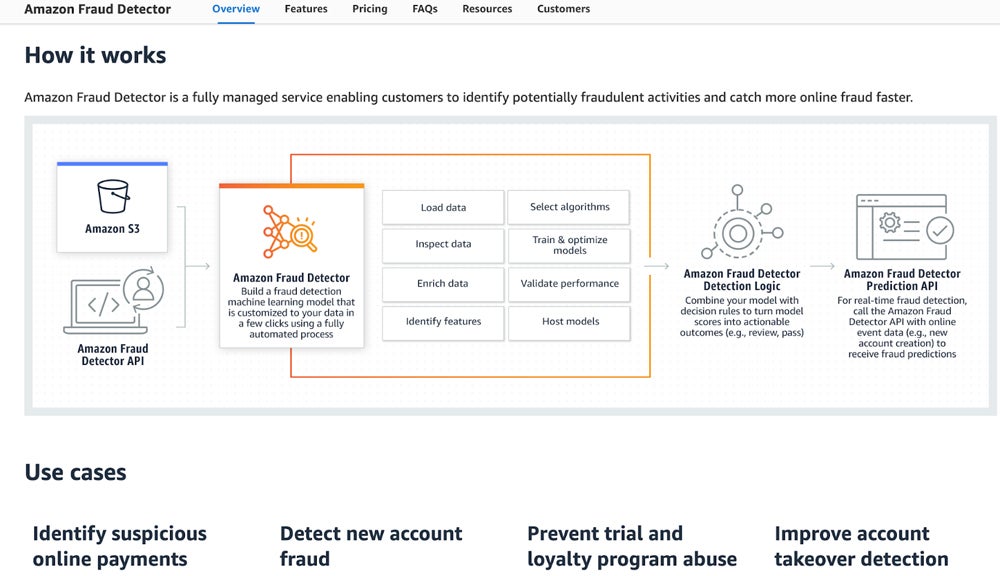 Amazon Fraud Detector as a traditional AI tool.
Amazon Fraud Detector as a traditional AI tool.
The Future of Traditional AI
The future of AI involves handling ever more complex and multifaceted real-world scenarios. Innovations will likely focus on enhancing the adaptability of rule-based systems, making them more flexible and capable of dealing with unforeseen situations. Expect to see enhanced flexibility and the rise of multimodal systems capable of processing many data types simultaneously. This will allow AI to tackle more complex enterprise challenges across multiple domains and significantly broaden its impact.
Self-improving AI systems are also emerging. They leverage reinforcement learning and dynamic analysis for autonomous optimization of performance over time. This will further enhance adaptability and efficiency without constant human intervention.
The integration of traditional AI with generative AI is expected to create hybrid systems that deliver an exponentially more powerful combination. Innovations in AI hardware and infrastructure, including specialized AI processors, will support these advanced systems. This will allow traditional AI to provide more sophisticated solutions across an expanding array of use cases.
Ethical Considerations
Generative AI and traditional AI face largely similar challenges in terms of ethics, including biases built into systems, job displacement and potential environmental impact.
Bias and Fairness
AI systems can inadvertently magnify biases that were built into their training data. These biases can lead to unfair outcomes, particularly for marginalized groups. To ensure fairness in AI, whether generative or traditional AI, there needs to be meticulous scrutiny of the training data, implementation of bias mitigation strategies, and continual monitoring of AI systems for biased behavior. Techniques like algorithmic fairness reviews and bias audits are a step toward promoting equity and inclusivity in AI applications.
Security and Privacy
The security and privacy concerns raised by the deployment of AI technologies are pervasive. AI systems often need vast amounts of data, including personal and sensitive information, to function effectively. Whether generative or traditional, ensuring robust data protection measures and maintaining privacy throughout the AI lifecycle are critical. This includes implementing strong encryption, data anonymization techniques, and complying with regulations such as GDPR. Transparency about data usage and incorporating user consent is also essential in building trust and safeguarding privacy.
Transparency and Explainability
For the ever-increasing reach and use cases of AI, we need to be able to trust AI and hold the technology accountable–and many users do not trust AI systems. This trust is enabled by transparency in AI systems. Explainable AI (XAI) practices allow users and stakeholders to understand how AI algorithms make decisions. By providing clear and understandable explanations of AI processes, organizations can enhance user trust and facilitate better decision-making. A transparent system makes it easy to identify and address any ethical issues and to ensure AI systems are used responsibly.
Job Displacement and Economic Impact
One of the greatest concerns about the rise of AI has been job displacement as automated systems replace human roles. Alleviating this issue calls for strategies for transitioning workforces to new or evolved roles, such as reskilling and upskilling programs to prepare employees for roles created by AI advancements. Organizations need to consider the broader social implications of deploying AI solutions and work to implement practices that strike a balance between technological progress and socioeconomic stability.
Environmental Impact
The deployment and training of large AI models, especially generative AI, requires significant computational resources, which leads to substantial energy consumption and environmental impact. Organizations using AI need to develop and implement energy-efficient AI models. They also need to optimize computational resources to minimize carbon footprints. Encouraging sustainable practices in AI development and operation is a must for reducing the environmental impact and promoting green AI technologies.
Top 3 Courses to Learn More About AI and Generative AI
Artificial intelligence in all its forms is advancing at a remarkable rate, so it’s advantageous for tech professionals to be knowledgeable about AI skills and developments. Here are relevant courses to help you use these technologies effectively. Please be aware that while each title below refers to generative AI, these courses all teach fundamental concepts that also cover overall AI technology.
Introduction to Generative AI by Google Cloud
This course provides a solid foundation in generative AI, covering fundamental concepts, model types, and practical applications. It’s suitable for those who are new to the field and want to explore the potential of generative AI using Google Cloud tools like Vertex AI.
Generative AI for Everyone by DeepLearning.AI
Andrew Ng’s course offers a comprehensive introduction to generative AI. It cuts across the workings, uses, and impact of generative AI in various industries. The course also includes hands-on exercises for applying the concepts you learn practically.
Generative AI with Large Language Models by AWS and DeepLearning.AI
Based on a partnership between AWS and DeepLearning.AI, this intermediate-level course goes into using large language models (LLMs) like GPT-4 for generative AI. It covers the architecture, training processes, practical applications of LLMs, and more. The course is designed for data scientists, AI developers, and anyone interested in mastering LLMs and applying them effectively in their work.
Frequently Asked Questions (FAQs)
Is Conversational AI the Same as Generative AI?
No, conversational AI and generative AI are related but distinct subsets of artificial intelligence. Conversational AI is designed to interact with users through dialogue, often used in chatbots and virtual assistants like Siri, Alexa, or Google Assistant. It focuses on understanding and generating human-like responses to deliver meaningful interactions. Generative AI, on the other hand, refers to AI systems that create new content based on learned patterns from existing data. While conversational AI can use generative AI techniques to give responses, generative AI covers a broader range of creative applications beyond just conversation.
What is the Difference Between Predictive AI and Generative AI?
Predictive AI focuses on analyzing existing data to forecast future events or trends. It uses techniques like regression analysis, time series analysis, and machine learning models to predict outcomes such as stock prices, weather conditions, or customer behaviors. Generative AI, however, aims to create new data rather than predict future events. It uses models like Generative Adversarial Networks (GANs) and Variational Autoencoders (VAEs) to generate new content that is similar to the training data.
Why Has Generative AI Taken Off So Quickly?
Generative AI has rapidly gained popularity due to several key factors. The development of sophisticated models like GPT-4, GANs, and VAEs has significantly improved the quality and realism of generated content. Increased access to high-performance computing resources such as GPUs and cloud computing has enabled the training of complex generative models. The vast amount of data available for training these models has allowed them to learn from diverse and extensive datasets, enhancing their capabilities. Plus, the wide range of applications—from creative industries like art and music to practical uses such as text generation and synthetic data creation—has driven interest and investment in generative AI.
Bottom Line: Generative AI and AI Have Separate Strengths
Generative AI and traditional AI each bring unique strengths and challenges to the table. Generative AI is geared for creativity, generating new and innovative content, and is seeing more integration into fields like art, music, and content creation. In contrast, traditional AI focuses on analyzing existing data to improve efficiency, accuracy, and decision-making, making it invaluable in sectors that value consistency and predictability such as finance, healthcare, and manufacturing.
As both these technologies continue to evolve rapidly, the differences between them will likely lessen, with generative AI’s creativity and AI’s data crunching strength found side by side in many advanced applications.
Read our guide to the Top 20 Generative AI Tools and Apps 2024 to learn more about what platforms organizations are using to deploy these dynamic technologies across their businesses.
